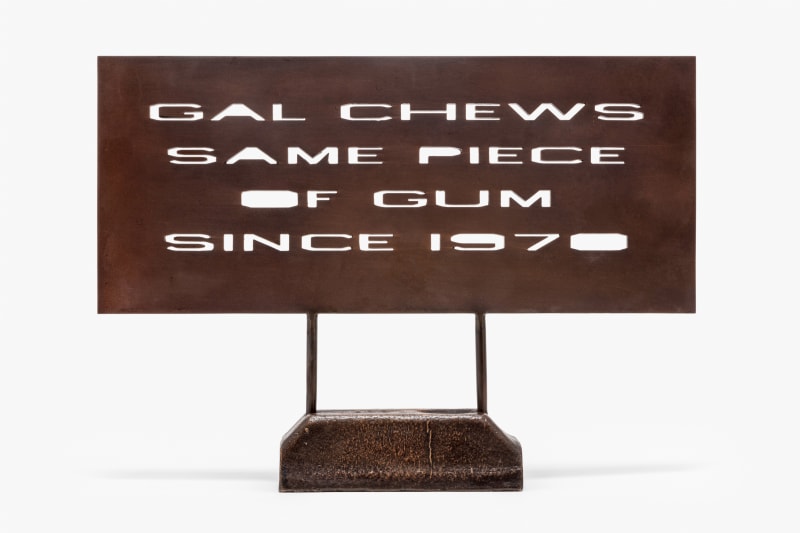I'm interested in glorifying something that we in the world would say doesn't deserve being glorified. Something that's forgotten, focused on as though it were some sort of sacred object.
-Ed Ruscha
GAL CHEWS GUM is a bronze edition that synthesizes multiple aspects of Ruscha’s iconic vision into a single form: text, signage, and shadows. The sculpture is fabricated through innovation of the lost wax method of bronze casting that dates back to the 3rd millennium BC. The bronze conjures a weathered road sign or billboard flashing the words ‘GAL CHEWS SAME PIECE OF GUM SINCE 1970.’ However, rather than conveying its message with eye-catching, brash graphics, the sign text is written in negative space with the letters cut out from the face of the sign in a stretched, horizontal font.
Variations of this text have appeared twice previously in Ruscha’s paintings (2008 and 2014), though with different backgrounds and compositions. Further, two works on paper (2016 and 2017) as well as a gravure print with aquatint (2019) also feature variants of the text, indicating the artist’s ongoing fascination with the phrase. In this edition, the viewer’s three-dimensional experience with the text varies depending on placement of the sculpture, light sources and the space it inhabits. As the light source or vantage point changes, the phrase is boldly legible or slyly obscured as the blankness of the cut-out words are filled and activated by whatever exists behind them. Calling to mind the painted trompe l’oeil shadows of Ruscha’s early “Ribbon Word” drawings, the sculpture casts a shadow with the block letters duplicated and hovering incandescent within the sign’s silhouette.
Since the 1960s, Ruscha has incorporated text into his practice, often finding inspiration in overheard phrases or advertising. His background as a commercial artist and sign painter is evident in his longtime exploration of the sign motif, which has been in his oeuvre for nearly six decades. In 1962, Ruscha created Twentysix Gasoline Stations which consisted of black and white photographs of gasoline stations taken by the artist. In 2004, The Lapis Press published a series of etchings by Ruscha that featured the sign motif, but the signs themselves are blank and create the negative space in the composition. In many ways, GAL CHEWS GUM is an extension of some of this earlier work which focused on every day or found objects, as well as the design and advertising that filled pedestrian life. Signage is often overlooked, but in the context of a bronze, the form carries new gravitas and acts as a readymade.
The base of GAL CHEWS GUM is cast from a metal ingot with a slightly textured surface that stands in contrast to the smooth, refined face of the sign. A basic component used in metal work, construction and manufacturing, the ingot’s raw, abstracted form exists in tension with the precise and clean-cut sign. When describing some of his paintings and works on paper, the artist noted: “I like the tension of having a combination of words, or a word, in front of something that is something lively itself…”. As with Lapis’ previous sculptural edition by Ed Ruscha, WEN OUT FOR CIGRETS (2017), shadow play is an integral component of GAL CHEWS GUM. The san serif font lends itself to this activated experience as the letters remain undisturbed, just slightly shifted as they fall behind the sculpture.
GAL CHEWS GUM speaks to several eras of Ruscha’s practice in creating something uniquely and simultaneously nostalgic, droll and modern. The phrase, ‘GAL CHEWS SAME PIECE OF GUM SINCE 1970’ with its colloquialism harkens internal images of small-town roadside attractions or local news headlines, however, by immortalizing the phrase in bronze, the artist invites the viewer to consider it in a new way. Ruscha once said, “I’m dead serious about being nonsensical.” Although this statement might initially read like an off-handed quip, it is highly representative of his practice and this new edition. His ability to stir the viewer’s imagination with a suggestive or illusive choice of words allows for both a conceptual and visual experience that leaves room for interpretation and delight.
